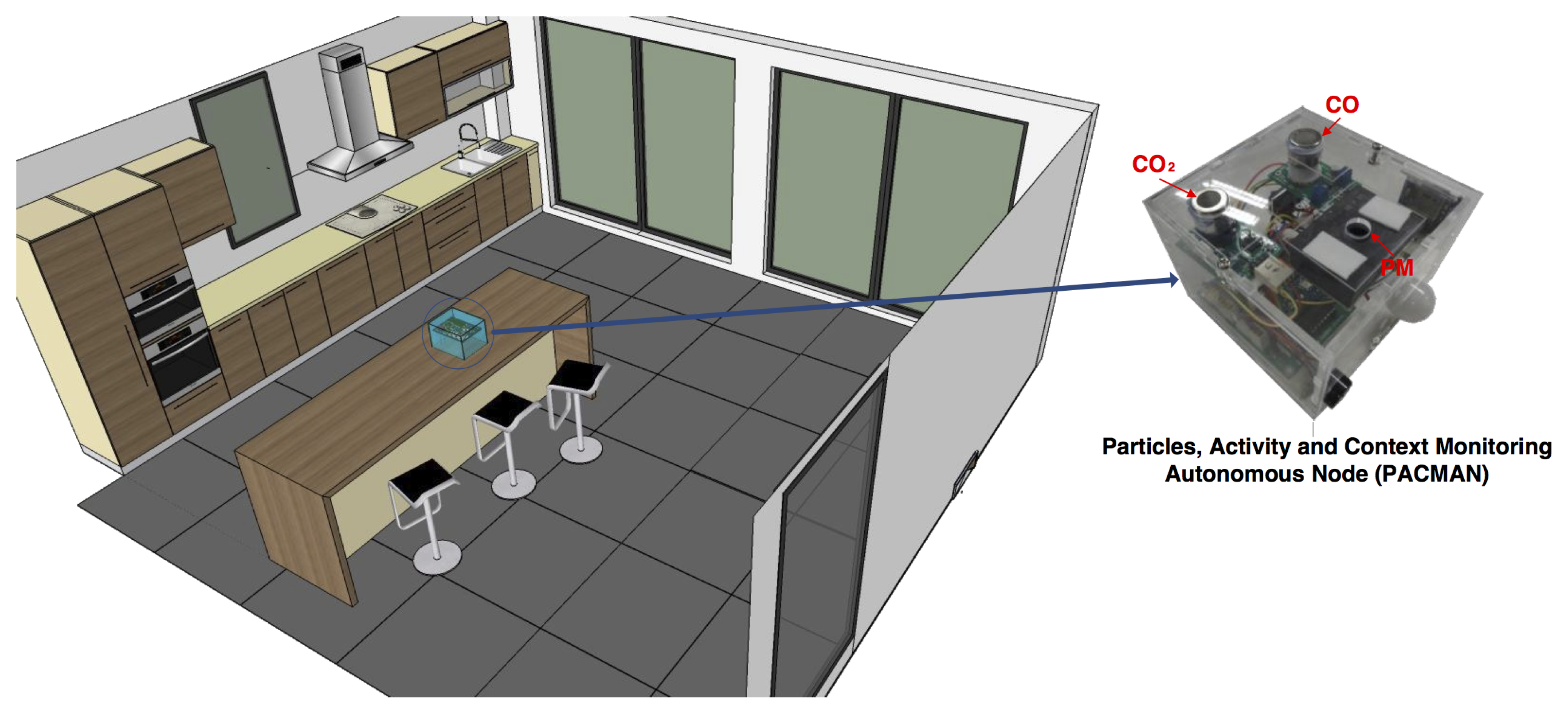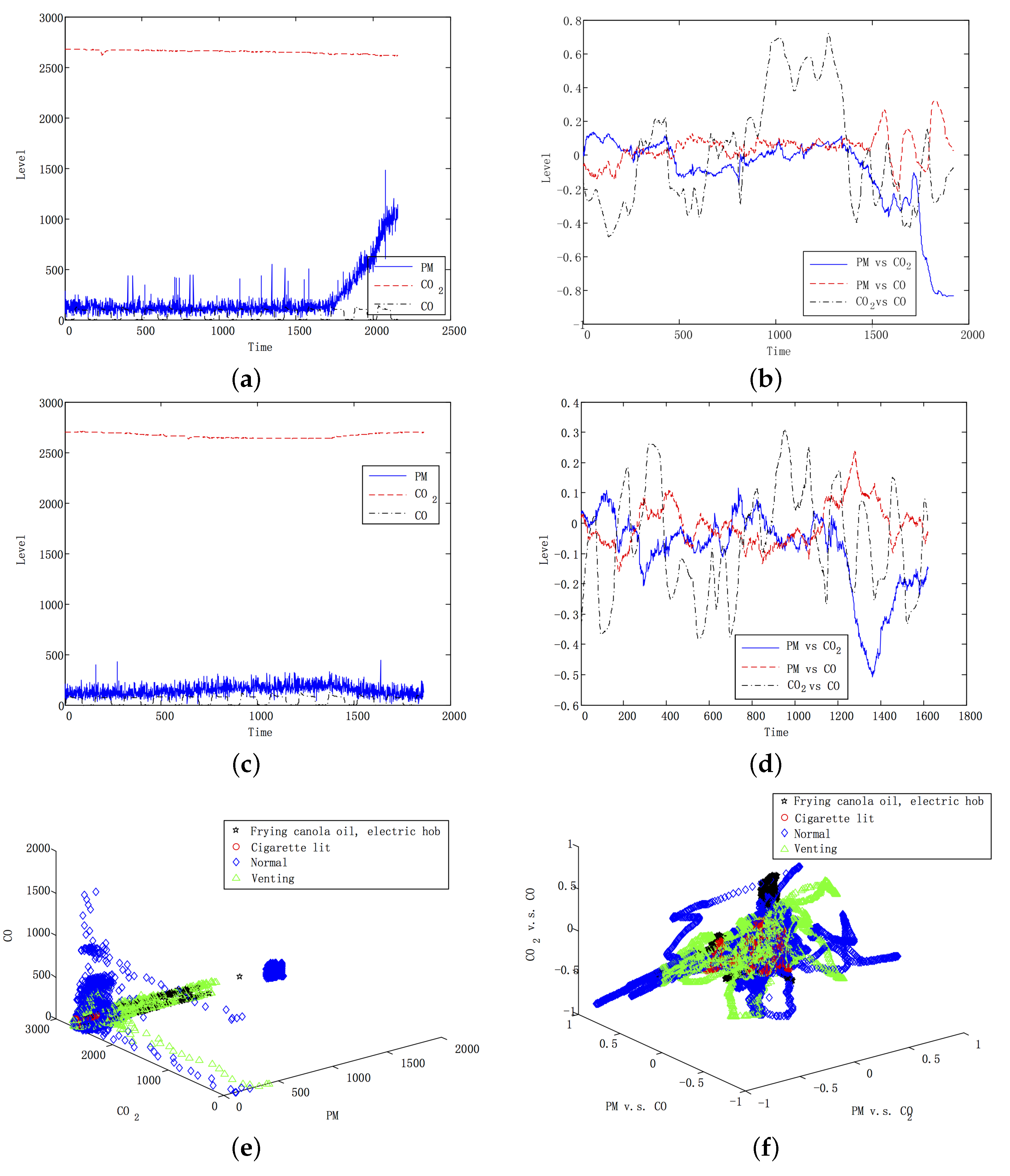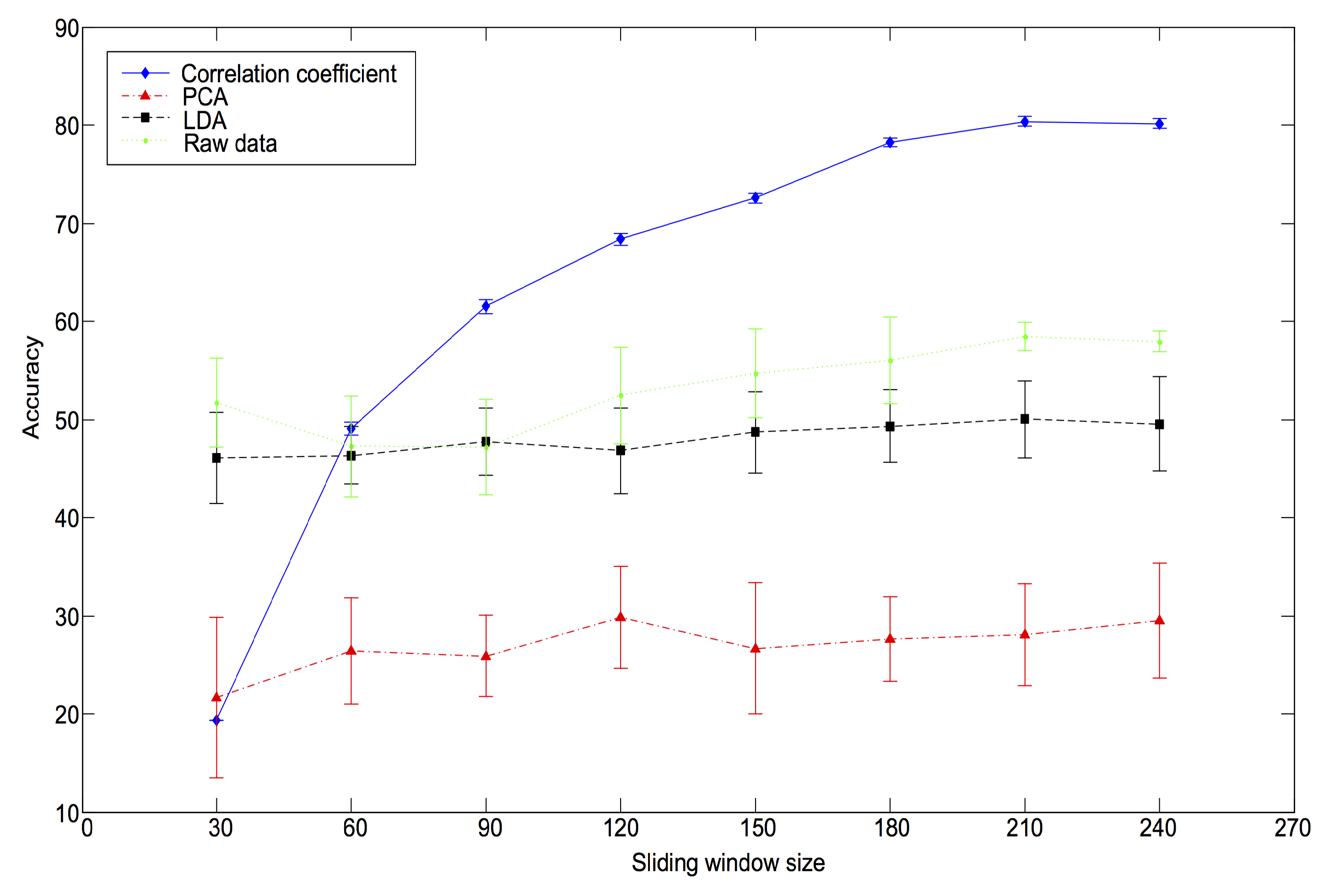Indoor Emission Sources Detection by Pollutants Interaction Analysis
Abstract
1. Introduction
1.1. Related Work
1.2. Motivation
1.3. Paper Organisation
2. Measurements and Method
2.1. Description of the Sampling Data
- Frying canola oil on an electric hob;
- Frying olive oil on an electric hob;
- Frying olive oil on a gas hob;
- Spraying of household pesticide;
- Lighting a cigarette and allowing it to smoulder.
2.2. Data Quality Control
2.3. Correlation Coefficient-Based Emission Sources’ Detection
2.3.1. Time Series Analysis
2.3.2. Data Filtering
2.3.3. Support Vector Machine Classification
3. Results
3.1. Pollutants Interaction Knowledge
3.2. Accuracy
3.3. Sensitivity and Robustness
4. Conclusions
Author Contributions
Funding
Institutional Review Board Statement
Informed Consent Statement
Conflicts of Interest
References
- Gurjar, B.R.; Molina, L.T.; Ojha, C.S.P. Air Pollution: Health and Environmental Impacts; CRC Press: Boca Raton, FL, USA, 2010. [Google Scholar]
- Amann, M.; Bertok, I.; Borken-Kleefeld, J.; Cofala, J.; Heyes, C.; Hglund-Isaksson, L.; Klimont, Z.; Nguyen, B.; Posch, M.; Rafaj, P.; et al. Cost-effective control of air quality and greenhouse gases in europe: Modeling and policy applications. Environ. Model. Softw. 2011, 26, 1489–1501. [Google Scholar] [CrossRef]
- Bönisch, U.; Böhme, A.; Kohajda, T.; Mögel, I.; Schütze, N.; von Bergen, M.; Simon, J.C.; Lehmann, I.; Polte, T. Volatile organic compounds enhance allergic airway inflammation in an experimental mouse model. PLoS ONE 2012, 7, e39817. [Google Scholar] [CrossRef]
- Heinrich, J. Influence of indoor factors in dwellings on the development of childhood asthma. Int. J. Hyg. Environ. Health 2011, 214, 1–25. [Google Scholar] [CrossRef]
- Wang, W.; Ramkumar, S.; Li, S.; Wong, D.; Iyer, M.; Sakadjian, B.B.; Statnick, R.M.; Fan, L.-S. Subpilot demonstration of the carbonation- calcination reaction (ccr) process: High-temperature co2 and sulfur capture from coal-fired power plants. Ind. Eng. Chem. Res. 2010, 49, 5094–5101. [Google Scholar] [CrossRef]
- Joly, M.; Peuch, V.-H. Objective classification of air quality monitoring sites over europe. Atmos. Environ. 2012, 47, 111–123. [Google Scholar] [CrossRef]
- Mas, S.; de Juan, A.; Tauler, R.; Olivieri, A.C.; Escandar, G.M. Application of chemometric methods to environmental analysis of organic pollutants: A review. Talanta 2010, 80, 1052–1067. [Google Scholar] [CrossRef] [PubMed]
- Watson, J.G.; Chow, J.C.; Chen, L.-W.A.; Lowenthal, D.H.; Fujita, E.M.; Kuhns, H.D.; Sodeman, D.A.; Campbell, D.E.; Moosmüller, H.; Zhu, D.; et al. Particulate emission factors for mobile fossil fuel and biomass combustion sources. Sci. Total. Environ. 2011, 409, 2384–2396. [Google Scholar] [CrossRef] [PubMed]
- Kong, S.; Han, B.; Bai, Z.; Chen, L.; Shi, J.; Xu, Z. Receptor modeling of pm2.5, pm10 and tsp in different seasons and long-range transport analysis at a coastal site of tianjin, china. Sci. Total. Environ. 2010, 408, 4681–4694. [Google Scholar] [CrossRef] [PubMed]
- Pacyna, E.G.; Pacyna, J.; Sundseth, K.; Munthe, J.; Kindbom, K.; Wilson, S.; Steenhuisen, F.; Maxson, P. Global emission of mercury to the atmosphere from anthropogenic sources in 2005 and projections to 2020. Atmos. Environ. 2010, 44, 2487–2499. [Google Scholar] [CrossRef]
- Wannaz, E.D.; Carreras, H.A.; Rodriguez, J.H.; Pignata, M.L. Use of biomonitors for the identification of heavy metals emission sources. Ecol. Indic. 2012, 20, 163–169. [Google Scholar] [CrossRef]
- Cuadros, J.F.; Melo, D.C.; Maciel Filho, R.; Wolf, M.R. Fluid catalytic cracking environmental impact: Factorial design coupled with genetic algorithms to minimize carbon monoxide pollution. Chem. Eng. 2012, 26, 243–248. [Google Scholar]
- Fisher, R.A. The use of multiple measurements in taxonomic problems. Ann. Eugen. 1936, 7, 179–188. [Google Scholar] [CrossRef]
- Marié, D.C.; Chaparro, M.A.; Gogorza, C.S.; Navas, A.; Sinito, A.M. Vehicle-derived emissions and pollution on the road autovia 2 investigated by rock-magnetic parameters: A case study from argentina. Studia Geophys. Geod. 2010, 54, 135–152. [Google Scholar] [CrossRef]
- Blasco, M.; Domeño, C.; López, P.; Nerín, C. Behaviour of different lichen species as biomonitors of air pollution by pahs in natural ecosystems. J. Environ. Monit. 2011, 13, 2588–2596. [Google Scholar] [CrossRef]
- Masiol, M.; Squizzato, S.; Ceccato, D.; Rampazzo, G.; Pavoni, B. A chemometric approach to determine local and regional sources of {PM10} and its geochemical composition in a coastal area. Atmos. Environ. 2012, 54, 127–133. [Google Scholar] [CrossRef][Green Version]
- Jolliffe, I.T. Principal Component Analysis; Springer: New York, NY, USA, 1986; Volume 487. [Google Scholar]
- Montoya-Mayor, R.; Fernández-Espinosa, A.J.; Ternero-Rodríguez, M. Assessment of the sequential principal component analysis chemometric tool to identify the soluble atmospheric pollutants in rainwater. Anal. Bioanal. Chem. 2011, 399, 2031–2041. [Google Scholar] [CrossRef] [PubMed]
- Huang, J.; Choi, H.-D.; Hopke, P.K.; Holsen, T.M. Ambient mercury sources in rochester, ny: Results from principle components analysis (pca) of mercury monitoring network data. Environ. Sci. Technol. 2010, 44, 8441–8445. [Google Scholar] [CrossRef]
- Wang, Z.; Luo, P.; Cheng, L.; Zhang, S.; Shen, J. Hapten–antibody recognition studies in competitive immunoassay of α-zearalanol analogs by computational chemistry and pearson correlation analysis. J. Mol. Recognit. 2011, 24, 815–823. [Google Scholar] [CrossRef] [PubMed]
- Makarewicz, J.C.; Lewis, T.W.; Boyer, G.L.; Edwards, W.J. The influence of streams on nearshore water chemistry, lake ontario. J. Great Lakes Res. 2012, 38, 62–71. [Google Scholar] [CrossRef]
- Rasmussen, D.; Fiore, A.; Naik, V.; Horowitz, L.; McGinnis, S.; Schultz, M. Surface ozone-temperature relationships in the eastern us: A monthly climatology for evaluating chemistry-climate models. Atmos. Environ. 2012, 47, 142–153. [Google Scholar] [CrossRef]
- Brudzynski, K.; Miotto, D. The relationship between the content of maillard reaction-like products and bioactivity of canadian honeys. Food Chem. 2011, 124, 869–874. [Google Scholar] [CrossRef]
- Olivares, G.; Longley, I.; Coulson, G. Development of a low-cost device for observing indoor particle levels associated with source activities in the home. In Technical Report, NIWA New Zealand; International Society of Exposure Science (ISES): Seattle, WA, USA, 2012. [Google Scholar]
- Hearst, M.A. Support vector machines. IEEE Intell. Syst. 1998, 13, 18–28. [Google Scholar] [CrossRef]




| Parameter | Sensor | Notes |
|---|---|---|
| Carbon monoxide (CO) | Hanwei MQ-7 | 72 h warm-up period |
| 90 s time resolution | ||
| Carbon dioxide (CO) | Hanwei MG-811 | 2 h warm-up period |
| Temperature (T) | LM335A | Measuring temperature |
| outside the enclosure | ||
| Movement (M) | PIR | 60 field-of-view |
| Distance (d) | Maxbotix range finder | 6.5 m range |
| Particulate Matter () | Dust sensor | baseline offset 1500 mV |
| The basic data structure, which can cover a majority of the indoor conditions | |
| t | The index of the time point |
| T | Total elapsed time |
| Samples at time t | |
| w | The size of the sliding window |
| M | The total number of observed pollutants |
| m | The index of the pollutant |
| The total number of subsequences | |
| i | The index of the sliding window |
| C | A set of matrices extracted by slicing time series with sliding window w |
| An extracted subsequence from the ith sliding window | |
| The correlation coefficient of two pollutants (i.e., jth and kth) for the ith sliding window |
| Correlation Coefficient | PCA | ||||||||||||||||
|---|---|---|---|---|---|---|---|---|---|---|---|---|---|---|---|---|---|
| Accuracy | Confusion Matrix | Accuracy | Confusion Matrix | ||||||||||||||
| 80.14% | class | 1 | 2 | 3 | 4 | 5 | 6 | 7 | 29.49% | class | 1 | 2 | 3 | 4 | 5 | 6 | 7 |
| 1 | 305.44 | 9.72 | 0.20 | 0.44 | 3.84 | 11.48 | 37.52 | 1 | 155.44 | 19.68 | 0.24 | 2.52 | 65.76 | 29.36 | 95.64 | ||
| 2 | 16.76 | 484.28 | 0.92 | 0.16 | 4.16 | 21.44 | 151.96 | 2 | 18.80 | 344.60 | 57.08 | 0.12 | 27.40 | 64.64 | 167.04 | ||
| 3 | 0.20 | 1.32 | 387.12 | 1.36 | 0.24 | 2.60 | 10.36 | 3 | 1.36 | 150.72 | 91.52 | 0.12 | 26.48 | 46.68 | 86.32 | ||
| 4 | 0.32 | 0 | 0.52 | 125.16 | 0.20 | 0.16 | 0.36 | 4 | 30.60 | 21.00 | 15.16 | 8.40 | 0 | 13.92 | 37.64 | ||
| 5 | 8.36 | 14.08 | 0.84 | 0.52 | 188.08 | 11.12 | 88.04 | 5 | 26.00 | 19.52 | 4.36 | 0.04 | 210.00 | 7.00 | 44.12 | ||
| 6 | 16.16 | 38.96 | 2.68 | 0.40 | 13.32 | 773.24 | 170.92 | 6 | 134.92 | 348.64 | 84.40 | 6.36 | 59.52 | 126.28 | 255.56 | ||
| 7 | 25.36 | 57.92 | 6.24 | 0.36 | 26.60 | 62.44 | 1882.20 | 7 | 388.96 | 295.96 | 282.04 | 11.68 | 233.52 | 259.52 | 589.44 | ||
| LDA | Without data filtering | ||||||||||||||||
| Accuracy | Confusion matrix | Accuracy | Confusion matrix | ||||||||||||||
| 49.54% | class | 1 | 2 | 3 | 4 | 5 | 6 | 7 | 57.95% | class | 1 | 2 | 3 | 4 | 5 | 6 | 7 |
| 1 | 3.76 | 1.20 | 0 | 0 | 2.88 | 24.92 | 335.88 | 1 | 57.00 | 5.48 | 0 | 0 | 0.68 | 0.92 | 304.56 | ||
| 2 | 2.96 | 304.44 | 0 | 12.20 | 1.40 | 13.16 | 345.52 | 2 | 1.08 | 580.64 | 0 | 0 | 0.84 | 36.24 | 60.88 | ||
| 3 | 0.28 | 0 | 343.60 | 0 | 0 | 0.04 | 59.28 | 3 | 0 | 0 | 403.20 | 0 | 0 | 0 | 0 | ||
| 4 | 0 | 0.76 | 0 | 17.24 | 0 | 0 | 108.72 | 4 | 5.08 | 0 | 0 | 100.16 | 0 | 0 | 21.48 | ||
| 5 | 8.96 | 0.00 | 0 | 0 | 5.24 | 39.40 | 257.44 | 5 | 0 | 0.04 | 0 | 0 | 7.44 | 1.64 | 301.92 | ||
| 6 | 27.96 | 16.88 | 25.08 | 0 | 23.52 | 273.44 | 648.80 | 6 | 31.24 | 75.88 | 2.52 | 0 | 37.84 | 381.40 | 486.80 | ||
| 7 | 37.20 | 61.44 | 38.76 | 32.60 | 48.92 | 227.28 | 1614.92 | 7 | 62.72 | 139.08 | 110.60 | 100.08 | 92.24 | 88.48 | 1467.92 | ||
| Feature Extraction Method | The Sliding Window Size | ||||||||
|---|---|---|---|---|---|---|---|---|---|
| 30 | 60 | 90 | 120 | 150 | 180 | 210 | 240 | ||
| Correlation coefficient | average accuracy | 19.32% | 49.06% | 61.50 % | 68.36% | 72.59% | 78.19% | 80.35% | 80.14% |
| growth | - | 29.74% | 12.44 % | 6.86 % | 4.23 % | 5.60% | 2.17% | −0.21 % | |
| stdev | 0.0001 | 0.6185 | 0.7064 | 0.6170 | 0.4945 | 0.4358 | 0.4906 | 0.4958 | |
| LDA | average accuracy | 46.06% | 46.32 % | 47.77% | 46.81% | 48.70% | 49.32% | 50.01% | 49.54% |
| growth | - | 0.26% | 1.45% | −0.96% | 1.89% | 0.63% | 0.69% | −0.47% | |
| stdev | 4.6216 | 2.9167 | 3.4096 | 4.3471 | 4.1156 | 3.6775 | 3.9270 | 4.7798 | |
| PCA | average accuracy | 21.61% | 26.44% | 25.91% | 29.82% | 26.68% | 27.63% | 28.07% | 29.49% |
| growth | - | 4.83% | −0.53% | 3.92% | −3.15% | 0.96% | 0.44% | 1.42% | |
| stdev | 8.1703 | 5.4214 | 4.1153 | 5.1970 | 6.6487 | 4.3547 | 5.1603 | 5.8455 | |
| Without data filtering | average accuracy | 51.74% | 47.27% | 47.17% | 52.45% | 54.69% | 56.01% | 58.47% | 57.95% |
| growth | - | −4.47% | −0.10 % | 5.28% | 2.24% | 1.33% | 2.45% | −0.52% | |
| stdev | 4.5254 | 5.1515 | 4.8287 | 4.95 | 4.5594 | 4.3840 | 1.4620 | 1.0551 | |
Publisher’s Note: MDPI stays neutral with regard to jurisdictional claims in published maps and institutional affiliations. |
© 2021 by the authors. Licensee MDPI, Basel, Switzerland. This article is an open access article distributed under the terms and conditions of the Creative Commons Attribution (CC BY) license (https://creativecommons.org/licenses/by/4.0/).
Share and Cite
Pang, S.; Song, L.; Sarrafzadeh, A.; Coulson, G.; Longley, I.; Olivares, G. Indoor Emission Sources Detection by Pollutants Interaction Analysis. Appl. Sci. 2021, 11, 7542. https://doi.org/10.3390/app11167542
Pang S, Song L, Sarrafzadeh A, Coulson G, Longley I, Olivares G. Indoor Emission Sources Detection by Pollutants Interaction Analysis. Applied Sciences. 2021; 11(16):7542. https://doi.org/10.3390/app11167542
Chicago/Turabian StylePang, Shaoning, Lei Song, Abdolhossein Sarrafzadeh, Guy Coulson, Ian Longley, and Gustavo Olivares. 2021. "Indoor Emission Sources Detection by Pollutants Interaction Analysis" Applied Sciences 11, no. 16: 7542. https://doi.org/10.3390/app11167542
APA StylePang, S., Song, L., Sarrafzadeh, A., Coulson, G., Longley, I., & Olivares, G. (2021). Indoor Emission Sources Detection by Pollutants Interaction Analysis. Applied Sciences, 11(16), 7542. https://doi.org/10.3390/app11167542






